How do Batters See the Ball? A Review of Gaze Research in Batting
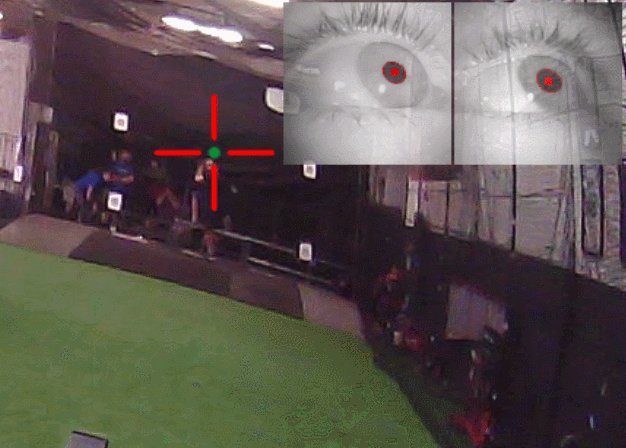
As access to ball-flight data becomes more readily available and intricate theories of pitch/swing design continue to increase in popularity within the player-development community, we can easily overlook one of the most arguably fundamental concepts of the game: how batters see the ball as it heads towards home plate.
While much has been written within the sabermetric community about tunneling, game theory, vision training, etc., few researchers have thoroughly reviewed what information sources hitters are attuned to and how these sources influence perception. Let’s take a deep dive into what we now know about gaze behavior and how that might affect our respective in-game approach.
Note: When we talk about gaze tracking, or gaze behavior, we’re talking about where a player is looking; that is, the movement of the hitter’s eyes and head as he tracks an incoming pitch.
This review is detailed and comprehensive, so if you only want a summation of the discussion, we recommend scrolling to the key takeaways at the end. For those who want all the gory details of gaze behavior in batting, let’s begin.
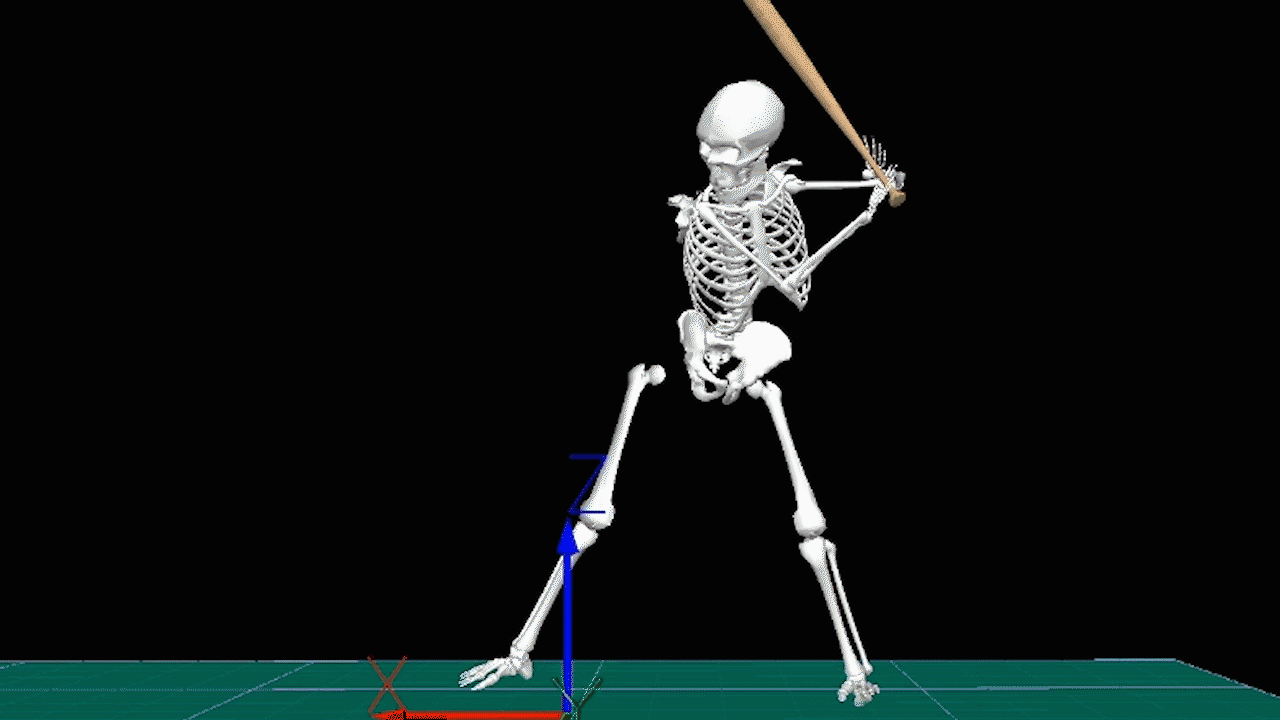
Foundations of Hitting
30 modules teaching you everything we know about hitting and hitting mechanics.
Intro to Batter Gaze Behavior and Basic Constraints
Research on batter gaze behavior started with the work of Hubbard and Seng in 1954, who used both qualitative observation (in-game) and cinematography (during BP) to analyze the head and eye movements of MLB and NCAA batters. Using relatively crude methods by today’s standards, the research concluded that batters tend to keep their head relatively fixated while tracking a pitch they intend to swing at (likely where the axiom “keep your head still” is derived from) and, more importantly, that eye movements of expert batters cannot track a pitch all the way to home plate.
Given the technological limitations at the time, it took until 1984 for anyone to publish a worthwhile attempt to replicate these findings and build on Hubbard and Seng’s paper. Researchers Bahill and LaRitz analyzed several college players and one MLB subject (Brian Harper) in their ability to track a wiffle ball attached to a fishing line propelled by a motor at greater than 60 mph (as you can imagine, batters were not permitted to swing).
Bahill and LaRitz’s main findings partially confirmed the work of Hubbard and Seng: batters were generally unable to follow a pitch in their central vision as it crossed home plate, despite the relatively low velocity of the incoming pitch and the batter’s inability to swing during the experiment. As noted in the paper, the average amateur player’s gaze falls behind the ball at roughly nine feet in front of home plate, whereas MLB participant Brian Harper was able to track the pitch until roughly five and a half feet in front of home plate.

Become the Hitter You Want To Be
Train at Driveline
Conceptually, this makes sense based on what we now know about smooth-pursuit eye movement and angular velocities of a baseball as it travels towards home plate. Although baseball players have a superior ability to track fast moving objects compared to the general population (Uchida et al., 2013), there are a couple of things working against them that make it extremely difficult to obtain useful information from the latter part of ball flight. First, the angular velocity of an incoming pitch can reportedly reach up to 750 deg/sec as it crosses home plate (Higuchi et al., 2018), which is well above the highest reported values of smooth-pursuit eye movements in humans of 120 deg/sec (Bahill & LaRitz, 1984). Second, batters are also constrained by visuo-motor delay, or the time it takes to react to an object’s change in trajectory. For example, it takes roughly 200-250 milliseconds for us to react to an unexpected ball and check our swing (Gray, 2009) or to react to an instant change in target trajectory in a finger-tracking task (Engel & Soechting, 2000).
As a result, when batters are occluded from seeing the last 150 milliseconds of ball flight, there are no significant differences in performance than if they were able to see the entire trajectory of an incoming pitch (Higuchi et al., 2016). With these results in mind, the concept of tunneling was born to take advantage of these limitations in batter perception.

However, like most complex topics related to human behavior, there are certainly more layers to batter gaze behavior to consider.
The Expert Way to See the Ball
As mentioned above, the MLB participant in Bahill and LaRitz’s research (Brian Harper) was able to see a pitch deeper in its trajectory relative to the lesser skilled participants. In doing so, Harper demonstrated an ability to produce faster smooth-pursuit eye movements and to couple both head and eye movement together, which dismisses the head-movement axiom promoted by Hubbard and Seng. This ability stands in opposition to the collegiate batters, who were only able to use either head or eye movement when tracking a pitch, but not both.
To add an additional caveat to the findings, one amateur batter in the Bahill and LaRitz study was able to use an anticipatory saccade during ball flight, which allowed him to align his gaze with the ball as it crossed home plate. Bahill and LaRitz noted that this batter was perhaps motivated to do this in order gain additional visual feedback on where the ball would have made contact with the bat, a form of feedback that we now know is important in batting (Gray, 2009). They coined this gaze strategy as the “optimal learning strategy,” in which batters sacrifice the ability to adjust their swings during the middle portion of ball flight in order to “park their gaze” at contact.
As a result, these findings provide a much more complex picture of how batters track the ball, as multiple strategies can seemingly be used by different batters of varying skill.

To explore this further, albeit in cricket, Land and McLeod (2000) sought to breakdown the differences in gaze behavior of three batters of varying skill levels using a pitching machine. In their experiment, they found all three batters used an anticipatory saccade at ball bounce and, more interestingly, that higher skilled batters initiated their saccades sooner.
Combing these results with those of Bahill and LaRitz, a straightforward takeaway might be that expert performers are simply better able to align their gaze ahead of the ball for the majority of ball flight, and that they employ a variety of unique skills to do this. However, we can only take away so much from these studies because they had serious design flaws.
Each participant faced some combination of below-average velocity, a pitching machine, or an inability to swing, which we know can drastically influence results between expert and novice performers (Mann, Abernethy, & Farrow, 2010). Furthermore, none of the recent studies mentioned above included truly elite participants.
To overcome these shortcomings, a 2013 cricket batting study was published by Mann, Spratford, and Abernethy, which included two elite professional cricket batters and two club-level cricket batters facing game-like velocities against a screen-based pitching simulator.
Supporting the findings of Land and McLeod as well as Bahill and LaRitz, the researchers found that expert batters initiated earlier saccades at ball-bounce and coupled both head and eye movements with greater efficiency. Expert batters were able to follow the ball with their heads egocentrically, meaning that they don’t need to move their eyes to keep the ball within their central vision.
However, instead of just simply relying on precise head movement, expert batters shifted their gaze to be farther ahead of the ball throughout the trajectory, even initiating a second anticipatory saccade just before bat-ball contact (like what Bahill and LaRitz found) so that their gaze was “parked” at contact point for the majority of trials.

On the other hand, club-level batters were much more likely to have their gaze trail behind the ball during its trajectory and were also less likely to initiate a second saccade. As a result, on good-length and short-length trials, expert batters aligned their gaze with the ball at contact on 100% and 90% of their respective trials, whereas club batters only aligned their gaze with the ball at contact on 13% and 70% of their respective trials.
Club batters also performed significantly worse by measures of contact scores, naturally providing more concrete evidence that predictive-gaze behavior and earlier/more frequent saccades is a hallmark of better batting performance and skill.
Is There Really an Expert Way to See the Ball?
Despite the solid experimental design, the 2013 study by Mann et al. also had its limitations. First, only four athletes participated in the study, so it’s difficult to say whether the gaze behavior of two elite and two club batters truly represented the general population. Second, although bounce length was varied, no curve was incorporated into the pitches that batters were told to swing at. Last, age was not controlled for, so we’re left unsure of whether this so-called expert gaze behavior is something that develops in early adolescence or later in a professional career.
To control for these issues, Sarpeshkar, Mann, and Abernethy (2017) published an excellent follow-up study with the hopes of replicating earlier findings related to gaze behavior in cricket batting. A total of 43 cricket batters were split up into four groups by skill (elite vs. club) and age (adult vs. college-aged batters). The batters faced two blocks of game-like pitches so that one block consisted of straight pitches only, whereas the other had a combination of curved and straight pitches to isolate for the effect of curved trajectories on gaze.
In looking at straight-blocked pitches only, the researchers had mixed results. They were unable to replicate the results found in Mann et al. (2013) that elite batters egocentrically tracked each pitch with their heads, because mean head angle for elite batters were relatively similar to that of club batters (3.1 deg vs. 3.7 deg). Furthermore, the researchers did not find any evidence that elite hitters initiated anticipatory saccades significantly earlier than club batters did.
However, it was shown that, on average, elite batters directed their gaze farther ahead of the ball compared to club batters (-.6 deg v. .4 deg), maintained more consistent gaze-head angle across different trials, were more likely to initiate a second saccade towards bat-ball contact, directed their gaze more towards the ball at bat-ball contact (46.1% vs. 26.1%), and had better performance at the plate. These findings held true regardless of whether an expert batter was an adult or “youth,” leading the researchers to conclude that elite gaze behavior develops during early adolescence.
But, when introducing just the possibility of curved trials into the experiment, the expert “advantage” all but disappeared to the extent that the performance of expert vs. club batters was indistinguishable. Gaze fell farther behind the ball in these trials, saccades were less frequent and delayed, and the probability of locating gaze at bat-ball contact decreased from 28.2% to 16.6%.
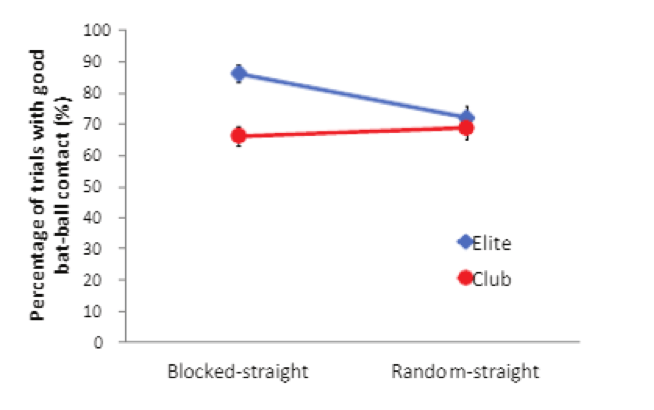
When actually adding curved pitches into the analysis, expert vs. club batting outcomes continued to decline and expert vs. club batting performance remained indistinguishable. However, there was evidence that expert batters were better able to functionally adapt their gaze to accommodate curving trajectories when compared to club batters. For example, elite batters directed their gaze towards “swinging” pitches more accurately than club batters on curving trajectories, and they used a higher proportion of oblique saccades than club batters did.

So, despite years of research highlighting the correlations between better performance and hallmarks of expert gaze behavior, that relationship almost all but disappears when even the possibility of a curving pitch is introduced.
Cognition Aiding Perception
The researchers state that these results emphasize the importance of top-down influences of expectations in visual-motor behavior. For example, expert batters are better able to account for relevant context to aid in their performance (Gray, 2002) and all batters perform better with advanced information on pitch probabilities prior to a given plate appearance (Gray, 2015). Perhaps in a more realistic setting, where pitch types aren’t varied at random, expert batters are better able to use context to maximize their advanced abilities to track the baseball with or without curve.
If this is true, this has significant implications related to sequencing, because a pitcher will have to weigh randomizing pitch types in conjunction with other concepts, such as tunneling or “waste pitches,” that are also hypothesized to negatively influence a batter’s perceptual capabilities.
For batters looking to improve their ability to track a baseball, perhaps learning the pitch-type tendencies of pitchers in different situations is a worthwhile endeavor compared to other visual-training modalities. If anything, the Sarpeshkar, Mann, and Abernethy paper indicates that even if a batter has elite gaze behavior, he’ll be unlikely to take advantage of this skill if he does not have an accurate idea of what pitch might be coming.
Bringing It Back to Baseball
Since we’ve spent the past three studies talking about cricket, it’s time to transition back to baseball.
After a thirty-year freeze in the research, Fogt and Zimmerman (2014) and Fogt and Persson (2017) completed two pilot studies using collegiate batters in a controlled lab environment where tennis balls were shot from a pitching machine at roughly 76 mph.
In conditions where batters were instructed not to swing, pitches were predominantly followed through head movement initially and batters incorporated eye movement later on during ball flight when the projectiles were travelling at a faster angular velocity. Within the 2017 paper, it was found that participants used an anticipatory saccade (as shown in Bahill & LaRitz, 1984) to follow the pitch as it crossed the plate, likely to generate a comparison relating early ball flight to final pitch location.
In the swinging condition, batters again relied on mostly head movement to track pitches during ball flight and were able to align their gaze with the ball until roughly five and a half feet to home plate. The key finding here was that despite allowing their participants to swing, the collegiate batters were still able to align gaze for just as long as Brian Harper was able to in the Bahill and LaRitz study.
The researchers speculate that despite not being able to use late ball-flight information to aid in performance (as reported by Higuchi et al., 2016) it may serve batters well in future ABs to continually track pitches for as long they can.
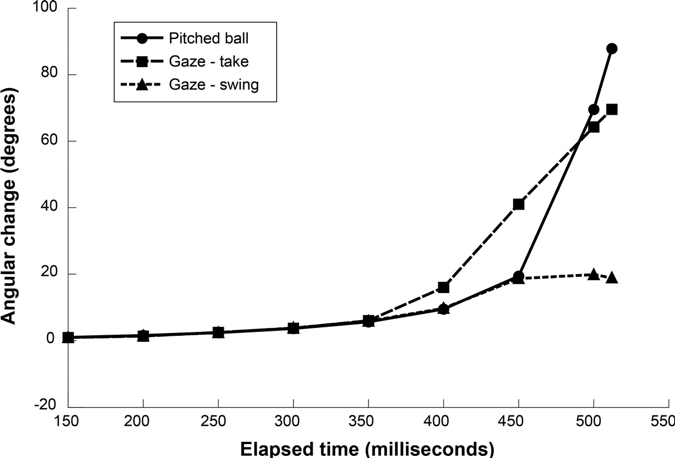
More recently, a paper by Higuchi et al. (2018) looked at the gaze behavior of six collegiate batters when facing a pitching machine set to fast and slow speed settings (90.15 mph / 71.4 mph). The researchers broke up ball flight into 4 1/5th intervals starting at 20% to see if the magnitude of head or eye movement significantly differed throughout ball flight. In both the fast and slow speed settings, head movement significantly increased later in ball flight, whereas eye movement was relatively minimized throughout.
They also found that within their group of six participants, three stopped moving their heads once their swings were initiated, while the other three continued to follow the ball with head movement for as long as possible. In particular, one subject demonstrated the ability to align his gaze with the ball at the moment of bat-ball contact, but the other five could not. However, unlike in the blocked-straight trials of the aforementioned cricket studies, the researchers found no correlation with the alignment of gaze at bat-ball contact and batting performance.
Therefore, in considering these results in conjunction with the two papers by Fogt and Zimmerman and Fogt and Persson, it is reasonable to conclude that head movement is the predominate driver of how a batter tracks a baseball pitch. This makes sense intuitively, given what we already know about the limitations of smooth-pursuit eye movements and the speed of incoming pitches.
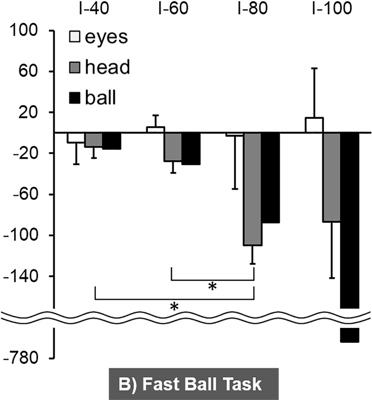
In fact, Higuchi et al. go one step further and suggest that rapid-eye movement during ball flight might actually be detrimental to performance in baseball batting, given that excessive changes in eye position may require too much processing time for the body to re-adjust its spatial relationship to the ball and the bat. While interesting, the Sarpeshkar, Mann, and Abernethy study indicates that we probably need a more thorough baseball-batting study that includes both expert and novice batters hitting against straight and curved trajectories at game-like velocities before we can derive a more specific conclusion such as that.
Wrapping Up the Research
Recapping over sixty years of gaze behavior research certainly leaves us with more questions than answers, but here’s what we know at this point in time.
How Do Batters Track the Ball?
More recent research has indicated that head movement plays a vital part in tracking a given pitch and that eye movement plays a minimal role at best. However, there has yet to be a published gaze-tracking study in baseball that has been able to attribute these behaviors to an increase or decrease in batting performance or against both straight and curved pitches.
How Long Do Batters Track the Ball?
There is strong evidence that the first 150ms of ball flight are vital to batting performance and that the last 150ms are irrelevant. However, we have yet to see that result replicated in an in situ environment that incorporates curved pitches and relevant game context.
This is problematic because we know in situ environments are critical to differentiating expert vs. novice performance, and we also know that some batters are able to align their gaze with the ball at contact. Furthermore, in a recent abstract published in the Journal of Sport & Exercise Psychology where two professional batters faced fifteen fastballs, fifteen curveballs, and fifteen changeups randomly ordered by type and location in a virtual environment, it was found that the temporal error at bat-ball contact could be predicted simply by the deviation of the batter’s gaze from the ball. It was also reported that temporal error was minimized when the head and ball were aligned at contact (Nakamoto, Fukuhara, & Mann, 2018).
Of course, we need these results to be published elsewhere to draw multiple conclusions from them, but this indicates that we have a lot more work to do before we can definitively say whether professional baseball batters are unequipped to track the ball over the last 150ms of ball flight and whether that information is irrelevant in hitting a baseball successfully.
Do Experts Track the Ball Differently Than Novices?
We do not exactly know how expert batters track a baseball compared to novices, because this question has not been investigated in over thirty years. In turning to cricket batting, expert batters have been found to align their gaze farther ahead of the incoming pitch, couple their gaze more closely with a pitch at bat-ball contact, and better accommodate their gaze strategies to follow curved pitches. That said, it is unclear whether any of this information translates to baseball batting.
If there is anything to take away between the differences in the gaze of expert and novice performers, it is that skilled batters may be better able to account for uncertainties in ball flight through advanced cues (Kato & Fakuda, 2002) and top-down cognitive influences (Gray, 2002). As a result, whatever advantage experts have as it relates to gaze may be leveraged during game-like context rather than a typical lab setting.
What Is Next?
In an attempt to fill this aforementioned gap in the literature, we’ve begun our own research on batter gaze behavior with the hopes of changing the way we understand how batters see the baseball. A lot of work needs to be done, but given the increasing interest in tackling more in-depth questions related to practice design and pitch sequencing, we believe that this will be a significant contribution to the baseball community when all is said and done.
A quick look into gaze tracking with @pupil_labs pic.twitter.com/wPkkjC3sEM
— Tanner Stokey (@Tstokey) January 24, 2019
Train at Driveline
Interested in training with us? Both in-gym and remote options are available!
- Athlete Questionnaire: Fill out with this link
- Email: [email protected]
- Phone: 425-523-4030
This article was written by Research Analyst Dan Aucoin
Comment section